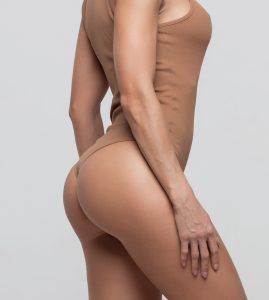 If you are considering having a Brazilian butt lift, you may be wondering how long it will take you to recover and when you can return to work. A Brazilian butt lift is a procedure that involves transferring fat from one part of the body to the buttocks to enhance the shape and size. Recovery times will vary depending on the individual, but typically you should be able to return to work within two weeks. In this blog post, we will discuss the recovery process and provide tips for preparing for a successful return to work after your Brazilian butt lift surgery. Board certified plastic surgeon Dr. Gary Motykie performs Brazilian Butt Lift surgery to patients in Beverly Hills, West Hollywood, Los Angeles, and surrounding locations.
If you are considering having a Brazilian butt lift, you may be wondering how long it will take you to recover and when you can return to work. A Brazilian butt lift is a procedure that involves transferring fat from one part of the body to the buttocks to enhance the shape and size. Recovery times will vary depending on the individual, but typically you should be able to return to work within two weeks. In this blog post, we will discuss the recovery process and provide tips for preparing for a successful return to work after your Brazilian butt lift surgery. Board certified plastic surgeon Dr. Gary Motykie performs Brazilian Butt Lift surgery to patients in Beverly Hills, West Hollywood, Los Angeles, and surrounding locations.
What is a Brazilian Butt Lift?
A Brazilian Butt Lift is a cosmetic surgery procedure that involves fat transfer to the buttocks. During the surgery, a plastic surgeon will extract fat from other parts of the patient’s body through liposuction, then purify and re-inject it into the buttocks. The aim of the procedure is to enhance the size, shape, and projection of the buttocks, creating a more aesthetically pleasing figure. This type of procedure is ideal for people who want to achieve a more curvaceous figure or have experienced weight loss that has left them with a sagging or flat butt. Brazilian Butt Lifts are becoming increasingly popular among both men and women, as it is a minimally invasive procedure with minimal scarring.
What to expect during the recovery period
After undergoing Brazilian Butt Lift surgery, you can expect a recovery period that will require you to take some time off from work. It is essential to follow your plastic surgeon’s post-operative instructions to ensure a smooth and safe recovery process.
During the first few days, you can expect to experience some discomfort, swelling, and bruising around the surgical site. You will be provided with pain medication to help manage any pain or discomfort you may feel during this period. It is crucial to stay hydrated and avoid sitting directly on your buttocks for an extended period to allow the area to heal properly.
Your plastic surgeon will also recommend that you wear a compression garment during the first few weeks after the procedure to reduce swelling and help maintain the new shape of your buttocks. You may also need to take antibiotics to prevent infection and keep the incision site clean and dry.
As your body heals, you can expect to see some changes in the shape and size of your buttocks. It is normal for the area to feel firm and swollen initially, but this will gradually subside over time. Your plastic surgeon will monitor your progress and advise you on when it is safe to resume your regular activities.
Overall, recovery from a Brazilian Butt Lift requires patience and adherence to post-operative care instructions. With proper care and attention, you can expect to achieve your desired results and return to your daily routine as soon as possible.
Typical recovery timeline for a Brazilian Butt Lift
If you’re considering a Brazilian Butt Lift (BBL), it’s important to understand the typical recovery timeline. BBL is a surgical procedure that involves removing fat from one area of the body and transferring it to the buttocks to achieve a more defined, shapely figure. Recovery from a BBL can vary depending on the patient’s individual circumstances, but the following timeline is a general guide to what you can expect:
- Immediately after surgery:
After the BBL surgery, you will be taken to a recovery area where you’ll be monitored by medical staff. You may experience some discomfort, swelling, and bruising. Pain medication and compression garments will be provided to help manage these symptoms.
- First week:
During the first week, you should rest as much as possible. You should avoid sitting or lying on your back, as this can put pressure on your buttocks and affect the outcome of the procedure. Instead, you should lie on your stomach or sides. You may also need to wear a compression garment during this time to help control swelling and support your new curves.
- Second week:
During the second week, you should continue to rest as much as possible and avoid any strenuous activities. You may start to feel more comfortable and the swelling should start to go down. You may also be able to stop wearing your compression garment.
- Third and fourth weeks:
During the third and fourth weeks, you can gradually start to increase your activity levels, but still avoid anything too strenuous. You can start to sit for short periods of time, but it’s still important to avoid sitting or lying on your back for too long.
- After six weeks:
After six weeks, most patients are able to return to work and resume normal activities. However, you should still avoid any activities that involve bouncing or jarring movements for a few more weeks.
It’s important to follow your surgeon’s postoperative instructions carefully to ensure the best possible outcome. Your recovery timeline may vary depending on the extent of your surgery and your body’s natural healing process. Be patient and give your body time to heal. The end result will be worth it!
When can you return to work after a Brazilian Butt Lift?
The answer to this question largely depends on the individual patient and the type of work they do. Generally speaking, most patients can return to work within 1-2 weeks after their Brazilian Butt Lift surgery. However, some patients may need more time off, especially if their job requires physical activity or long periods of sitting.
During the first few days after your surgery, it’s important to take it easy and rest as much as possible. You’ll likely experience some discomfort, swelling, and bruising, and you’ll need to avoid sitting or lying on your buttocks for at least a week or two. You may also need to wear a compression garment to help reduce swelling and support your new curves.
Once your initial recovery period is over, you can gradually start to increase your activity level. However, you should still avoid sitting or lying directly on your buttocks for at least a few more weeks. If you have a job that requires prolonged periods of sitting, you may need to take extra time off or make arrangements for a special cushion or chair that will allow you to sit without putting pressure on your buttocks.
Overall, it’s important to listen to your body and follow your surgeon’s recommendations for a safe and successful recovery. If you have any concerns or questions about returning to work after your Brazilian Butt Lift, be sure to discuss them with your surgeon before your surgery.
Contact Beverly Hills Board Certified Plastic Surgeon Dr. Gary Motykie to Schedule a Consultation
Click Here for Virtual Consultation
Click Here to Schedule a In Office Consultation
To see more services and treatments provided by Board Certified Plastic Surgeon, Dr. Motykie in Beverly Hills | Los Angeles | West Hollywood, CA and his team please visit:


 Are you considering having
Are you considering having 